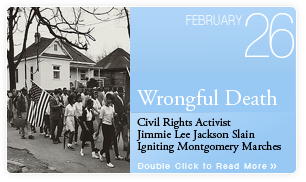Wrongful Death—Civil Rights Activist Jimmie Lee Jackson Slain Igniting [Montgomery] Marches
In 1965, Jimmie Lee Jackson died on this day after being shot by a state trooper in Alabama. Born in 1938, Jackson had tried to register to vote for four years with no success. Ordained in 1964, he was a deacon at St. James Baptist Church. Inspired by the Southern Christian Leadership Coalition (SCLC) and Student Nonviolent Coordinating Committee’s (SNCC) campaign against Negro voting restrictions in Alabama, which was led by Dr. Martin Luther King, Jr., he began attending civil rights meetings a few times a week at Zion’s Chapel Methodist Church in Marion, AL. On February 18 he was among roughly 500 people leaving a church meeting to walk to the nearby Perry County Jail where a civil rights worker was incarcerated. The marchers’ plan was to walk to the jail and back to the church while singing hymns. The police later said that they believed the crowd was attempting a jailbreak. They encountered a line of police officers, sheriff’s deputies and Alabama State Troopers blocking their procession. Recounting the incident later, people said the streetlights turned off abruptly and the police commenced beating the protestors. As the crowd began to scatter, Jackson, along with his mother and octagenarian grandfather, ran into a café behind the church to seek refuge. State troopers followed them and clubbed Jackson’s grandfather and mother, who had attempted to pull the police off of the grandfather. Jackson tried to protect his mother, but was pushed back and then shot twice in the stomach. He attempted to flee while still being beaten and made it to the bus station where he collapsed. He died eight days later at Good Samaritan Hospital in Selma and was buried in Heard Cemetery. In response to his death, James Bevel of the SCLC, along with King and SNCC, worked to organize a march from Selma to Montgomery, the capital of Alabama. It was planned for March 7, 1965 with the premeditated goal of asking Governor George Wallace if he was complicit in the incident. Wallace denounced the march as a threat to public safety and vowed to take any measures necessary to stop it. 600 marchers gathered and began marching peacefully. When they crossed the Edmund Pettus Bridge they found state and local police officers waiting for them. The officers began attacking them almost immediately with tear gas and nightsticks, as well as mounted officers charging into the crowd on horseback. Seventeen protesters were hospitalized, causing the event to be known as “Bloody Sunday.” The shocking images of nonviolent protesters assaulated and brutalized from the march ran on television and in newspapers across the country, revealing the brutality of the Jim Crow era and galvanizing support for the Civil Rights movement. A second march was attempted on March 9, but a judge blocked the march until after a hearing and the protesters turned back after a prayer. The march finally occurred on March 25, when 8,000 protestors began walking the 54 mile journey with an escort of 2,000 U.S. soldiers, 1,900 Federally-commanded Alabama National Guard members and additional FBI agents and Federal Marshals. Ending on the steps of the state capitol with 25,000 marchers, King gave his famous “How Long, Not Long” speech, saying, “How long? Not long, because the arc of the moral universe is long, but it bends toward justice.” In September of that year, a grand jury declined to indict the state trooper, James Fowler, who had shot Jackson. Additionally, he returned to his work without so much as a letter reprimanding him. 42 years later in 2007 he was charged with first and second degree murder for Jackson’s death. His trial is delayed pending charges for a second murder in 1966.

